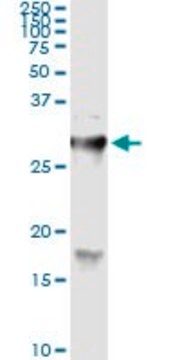MABT1438
Anti-HYAL1 Antibody, clone 1D10
About This Item
Produits recommandés
Source biologique
mouse
Niveau de qualité
Conjugué
unconjugated
Forme d'anticorps
purified antibody
Type de produit anticorps
primary antibodies
Clone
1D10, monoclonal
Poids mol.
calculated mol wt 48.37 kDa
observed mol wt ~52 kDa
Produit purifié par
using protein G
Espèces réactives
human, mouse, hamster
Conditionnement
antibody small pack of 100 μL
Technique(s)
immunohistochemistry (formalin-fixed, paraffin-embedded sections): suitable
western blot: suitable
Isotype
IgG1κ
Séquence de l'épitope
Unknown
Numéro d'accès Protein ID
Numéro d'accès UniProt
Conditions d'expédition
2-8°C
Modification post-traductionnelle de la cible
unmodified
Informations sur le gène
human ... HYAL1(3373)
Description générale
Spécificité
Immunogène
Application
Evaluated by Western Blotting in Mouse kidney tissue lysate.
Western Blotting Analysis: A 1:500 dilution of this antibody detected Hyaluronidase-1 in Mouse kidney tissue lysate.
Tested Applications
Western Blotting Analysis: A 1:500 dilution from a representative lot detected HYAL1 in Mouse liver tissue lysate.
Western Blot using KO lysates: A 1:500 dilution from a representative lot detected HYAL1 in lysate from wild-type liver tissue, but not in mouse liver with HYAL1 knockout. (Data courtesy of Dr. Barbara Triggs-Raine, Ph.D., University of Manitoba, Canada).
Western Blotting Analysis: A representative lot detected HYAL1 in Western Blotting application. (Shuttleworth, T., et al. (2002). J Biol Chem. 277(25):23008-18; Martin, D.C., et al. (2008). Hum Mol Genet. 17(13):1904-15; Hemming, R., et al. (2008). Glycobiology. 18(4):280-9; Puissant, E., et al. (2014). Traffic. 15(5):500-15).
Immunohistochemistry Applications: A representative lot detected HYAL1 in Immunohistochemistry application. (de Sa, V.K., et al. (2015). Braz J Med Biol Res. 48(11):1039-47).
Note: Actual optimal working dilutions must be determined by end user as specimens, and experimental conditions may vary with the end user
Forme physique
Stockage et stabilité
Autres remarques
Clause de non-responsabilité
Vous ne trouvez pas le bon produit ?
Essayez notre Outil de sélection de produits.
Code de la classe de stockage
12 - Non Combustible Liquids
Classe de danger pour l'eau (WGK)
WGK 1
Point d'éclair (°F)
Not applicable
Point d'éclair (°C)
Not applicable
Certificats d'analyse (COA)
Recherchez un Certificats d'analyse (COA) en saisissant le numéro de lot du produit. Les numéros de lot figurent sur l'étiquette du produit après les mots "Lot" ou "Batch".
Déjà en possession de ce produit ?
Retrouvez la documentation relative aux produits que vous avez récemment achetés dans la Bibliothèque de documents.
Notre équipe de scientifiques dispose d'une expérience dans tous les secteurs de la recherche, notamment en sciences de la vie, science des matériaux, synthèse chimique, chromatographie, analyse et dans de nombreux autres domaines..
Contacter notre Service technique








